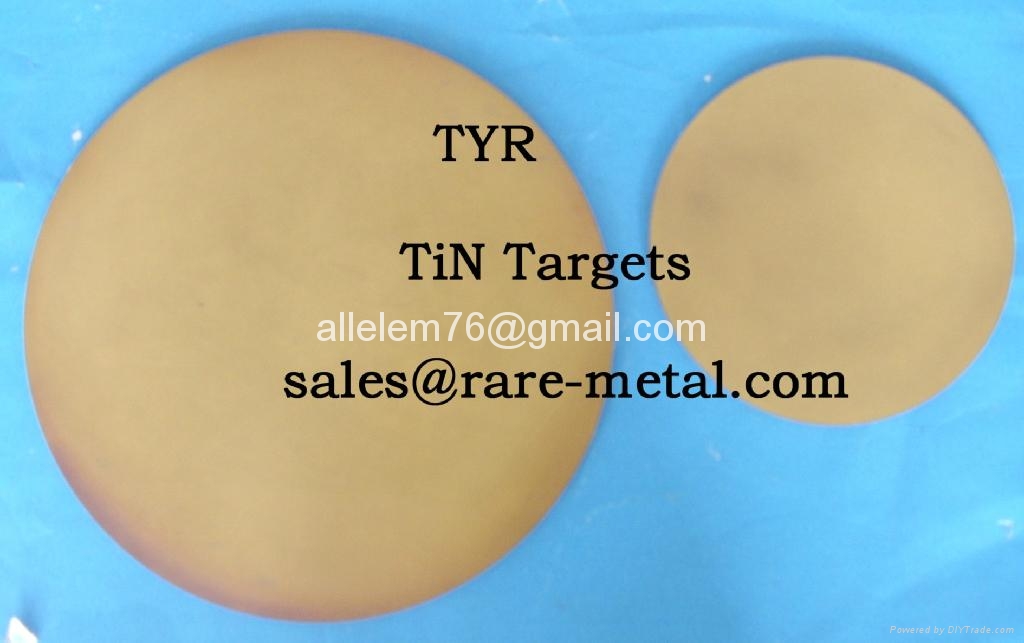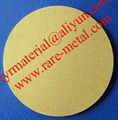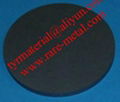
Titanium nitride TiN sputtering targets CAS 25583-20-4
Model No.︰
TiN
Brand Name︰
TYR
Country of Origin︰
China
Unit Price︰
US $ 100 / pc
Minimum Order︰
1 pc
Product Description
Titanium Nitride (TiN) ceramic sputtering target
Purity: 99.5%
Size: Diameter: 355.6mm (14") max.
Single piece Size: Length: <350mm, Width: <250mm, Thickness: >1mm,
if larger size than this, we can do it as Tiles joint by 45 degree or 90 degree
Shape: discs, plate, rod, tube, sheet, Delta, Rotatable and per drawing
Molar mass 61.874 g/mol
Appearance Coating of golden color
Odor Odorless
Density 5.22 g/cm3
Melting point 2,930 °C (5,310 °F; 3,200 K)
Titanium nitride (TiN) (sometimes known as tinite) is an extremely hard ceramic material, often used as a coating on titanium alloys, steel, carbide, and aluminium components to improve the substrate's surface properties.
Applied as a thin coating, TiN is used to harden and protect cutting and sliding surfaces, for decorative purposes (due to its gold appearance), and as a non-toxic exterior for medical implants. In most applications a coating of less than 5 micrometres (0.00020 in) is applied.
A well-known use for TiN coating is for edge retention and corrosion resistance on machine tooling, such as drill bits and milling cutters, often improving their lifetime by a factor of three or more.
Because of TiN's metallic gold color, it is used to coat costume jewelry and automotive trim for decorative purposes. TiN is also widely used as a top-layer coating, usually with nickel (Ni) or chromium (Cr) plated substrates, on consumer plumbing fixtures and door hardware. As a coating it is used in aerospace and military applications and to protect the sliding surfaces of suspension forks of bicycles and motorcycles as well as the shock shafts of radio controlled cars. TiN is non-toxic, meets FDA guidelines and has seen use in medical devices such as scalpel blades and orthopedic bone saw blades where sharpness and edge retention are important. TiN coatings have also been used in implanted prostheses (especially hip replacement implants) and other medical implants.
Though less visible, thin films of TiN are also used in microelectronics, where they serve as a conductive barrier between the active device and the metal contacts used to operate the circuit. The film blocks the diffusion of metal of the conductor into the silicon, but it is conductive enough (30–70 μΩ·cm) to allow a good electrical connection. In this context, TiN is classified as a "barrier metal", even though it is clearly a ceramic from the perspective of chemistry or mechanical behavior. Recent chip design in the 45 nm technology and beyond also makes use of TiN as a metal material for improved transistor performance. In combination with gate dielectrics (e.g. HfSiO) that have a higher permittivity compared to standard SiO2 the gate length can be scaled down with low leakage, higher drive current and the same or better threshold voltage. TiN has also been used in fusion power experiments due to its ability to tightly bond with oxygen molecules.
Due to their high biostability, TiN layers may also be used as electrodes in bioelectronic applications like in intelligent implants or in-vivo biosensors that have to withstand the severe corrosion caused by the body fluid. TiN electrodes have already been applied in the subretinal prosthesis project as well as in biomedical microelectromechanical systems (BioMEMS).
We also supplying other nitride targets material as following:
Aluminum Nitride , AlN target
Boron Nitride, BN target
Hafnium Nitride, HfN target
Niobium Niride , NbN target
Silicom Nitride , Si3N4 target
Tantalum Nitride , TaN target
Titanium Carbon nitride , TiCN target
Titanium Nitride, TiN target
Tungsten Nitride, WN targets
Vanadium Nitride , VN target
Zirconium Nitride , ZrN target
Size: Diameter: 355.6mm (14") max.
Single piece Size: Length: <350mm, Width: <250mm, Thickness: >1mm,
if larger size than this, we can do it as Tiles joint by 45 degree or 90 degree



